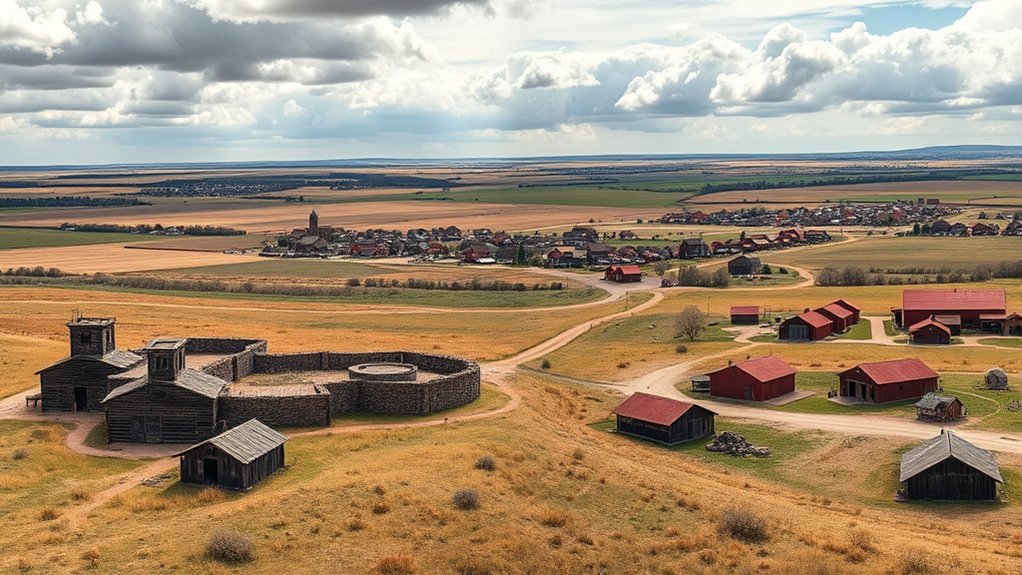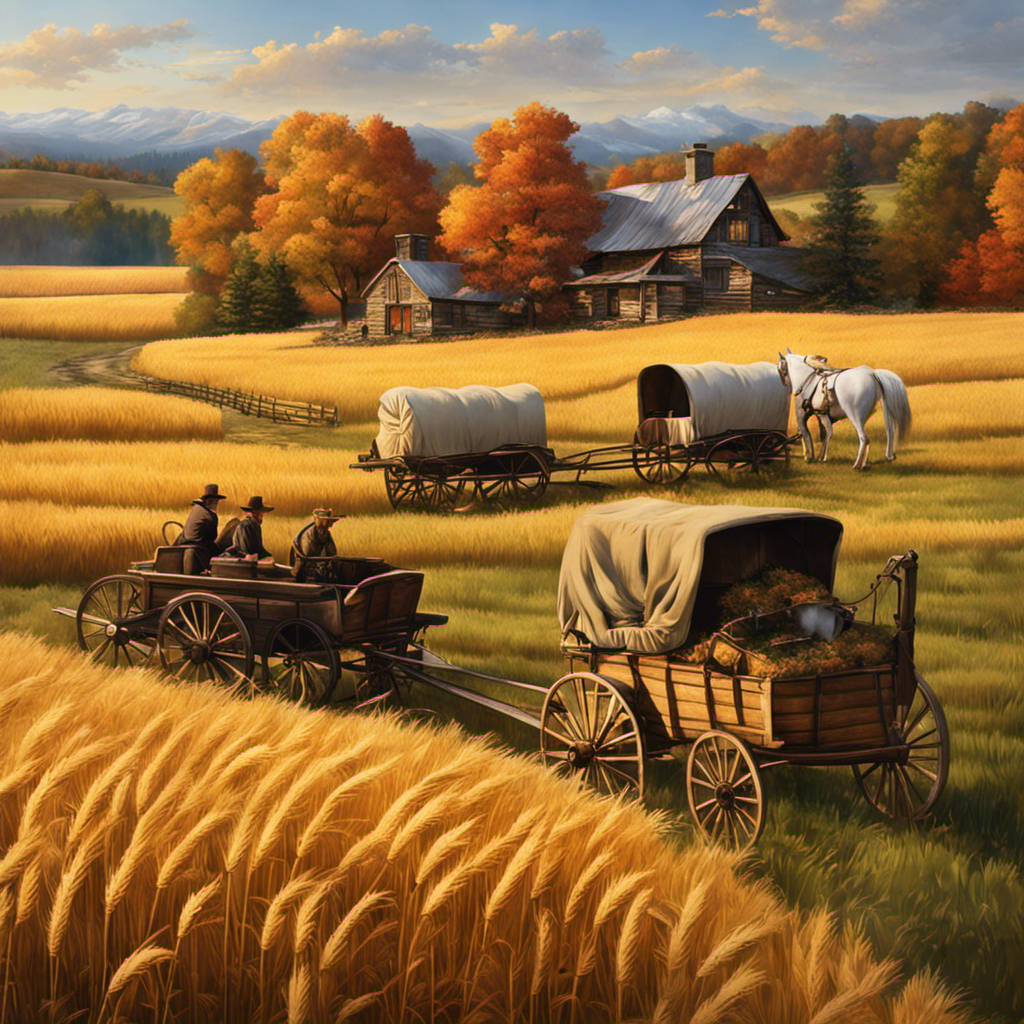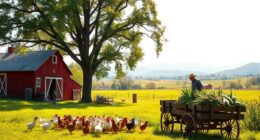You’ll see that frontier regions started as trading posts, serving as hubs for exchanging goods and forming Native American relations. Over time, these trading posts developed into permanent settlements attracting settlers and traders. As tensions or alliances grew, some settlements became frontier forts for military protection. Eventually, villages emerged around forts as self-sustaining communities blending Native American influences. To understand how these stages shaped the frontier’s evolution and relations, explore the detailed timeline ahead.
Key Takeaways
- Frontier forts shifted focus from military defense to symbols of sovereignty during territorial expansion.
- Trading posts served as the initial hubs, later evolving into permanent settlements and farm villages.
- Forts often acted as strategic points influencing Native American relations, leading to negotiations or conflicts.
- Farm villages developed around forts, integrating Native influences and fostering local governance and trade.
- The overall transition from forts to villages marked increased stability, community growth, and frontier development.

The timeline of frontier forts and farm villages reveals a dynamic history of settlement and defense along expanding frontiers. As settlers moved westward, establishing trading posts became a critical first step. These trading posts served as hubs where goods, information, and culture exchanged hands. They weren’t just centers of commerce; they played an essential role in shaping Native American relations. Early on, traders often acted as intermediaries, fostering communication between indigenous communities and newcomers. Sometimes, this led to peaceful alliances, but other times, it sparked tension and conflict. Understanding the development of trading posts helps you see how economic interests intertwined with complex Native American interactions, influencing the stability of frontier regions.
Trading posts were essential hubs shaping Native American relations and frontier stability.
As trading post development progressed, these establishments evolved into more permanent settlements. They attracted not only traders but also settlers seeking new opportunities. This shift often prompted negotiations and treaties with Native American tribes, aiming to secure land rights and establish peaceful coexistence. However, relations varied widely depending on the tribes and the policies of the settlers or government. In some areas, traders and settlers worked to maintain respectful relationships, while in others, competition for resources and land led to hostilities. Recognizing these dynamics is key to understanding how frontier communities grew and how Native American relations impacted their development.
Over time, the focus of frontier expansion shifted from isolated trading posts to fortified frontier forts. These forts provided military protection against potential threats, including hostile tribes or rival colonial powers. They also served as symbols of sovereignty and control, signaling that settlers and authorities intended to secure their claims. The presence of forts often changed the nature of Native American relations, sometimes leading to confrontations but also to negotiations and treaties that aimed to establish boundaries or alliances. The development of these forts wasn’t just about defense; it reflected broader strategies of territorial expansion, economic integration, and diplomatic engagement with indigenous nations.
Eventually, as frontier regions became more populated and stable, farm villages emerged around these forts. These villages represented a shift toward self-sustaining communities, blending Native American influences with settler traditions. They became centers of local governance, trade, and culture. The transition from trading posts to farm villages illustrates the evolution of frontier life—from transient trading hubs to permanent settlements that laid the groundwork for future states. Throughout this process, Native American relations remained a constant factor, shaping policies, influencing settlement patterns, and determining the region’s stability. This ongoing interaction underscores how frontier development was as much about diplomacy and adaptation as it was about conquest or expansion.
A better understanding of trading post development helps reveal how economic, diplomatic, and military strategies intertwined during frontier expansion.
Frequently Asked Questions
How Did Indigenous Peoples Influence Frontier Fort Development?
You see, indigenous peoples notably influenced frontier fort development through Indigenous alliances and cultural influences. By forming alliances, they helped settlers understand local terrain and navigate conflicts, shaping fort placement and design. Their cultural influences also impacted building techniques and defensive strategies, ensuring forts integrated local knowledge. This collaboration fostered mutual protection and adaptation, making frontier forts more effective in safeguarding settlers while respecting indigenous traditions and knowledge.
What Were the Main Challenges Faced by Early Farm Villages?
You face main challenges like indigenous resistance and resource scarcity. Indigenous resistance often threatened your safety and land access, making expansion difficult. Resource scarcity, such as limited water, timber, and fertile soil, hampers your ability to grow crops and sustain livestock. These obstacles force you to adapt quickly, find new land, or develop innovative solutions to survive and thrive in early farm villages.
How Did Transportation Evolve Between Forts and Villages?
You can’t put the cart before the horse, and transportation evolved from simple horse-drawn carriages to complex canal systems. As villages grew, people relied more on waterways for efficient movement of goods and people between forts and farms. Over time, canals reduced travel time and increased trade, making transportation more reliable and faster. This evolution helped communities expand and thrive, connecting remote areas and fostering economic growth.
What Role Did Trade Play in Frontier Settlement Growth?
Trade played a vital role in frontier settlement growth by fostering economic exchange and cultural interactions. As you engage in trade, you connect with other settlers and Native communities, exchanging goods, ideas, and traditions. This exchange boosts local economies and encourages diverse cultural influences, making settlements more vibrant. You’ll find that trade routes stimulate further settlement development, turning small villages into thriving communities driven by shared commerce and mutual cultural understanding.
How Did Technological Advances Impact Frontier Defenses?
Technological advances greatly improved frontier defenses by introducing advanced weaponry that made fortifications more effective and resilient. You’d also benefit from improved communication networks, which allowed quicker alerts and coordinated responses to threats. These innovations helped settlers defend their lands better, deterred attacks, and maintained safety. As a result, frontier settlements could grow more confidently, knowing they had stronger defenses supported by modern weaponry and faster communication systems.
Conclusion
As you see, these frontier forts and farm villages shaped the land’s story, proving resilience and adaptability. Some might think progress means always moving forward, but this timeline shows how roots deepen as communities grow. Embrace the idea that growth includes honoring history and learning from it. Your journey, like theirs, is about building something lasting—grounded in the past, ready for the future. It’s a testament to how perseverance creates true progress.










